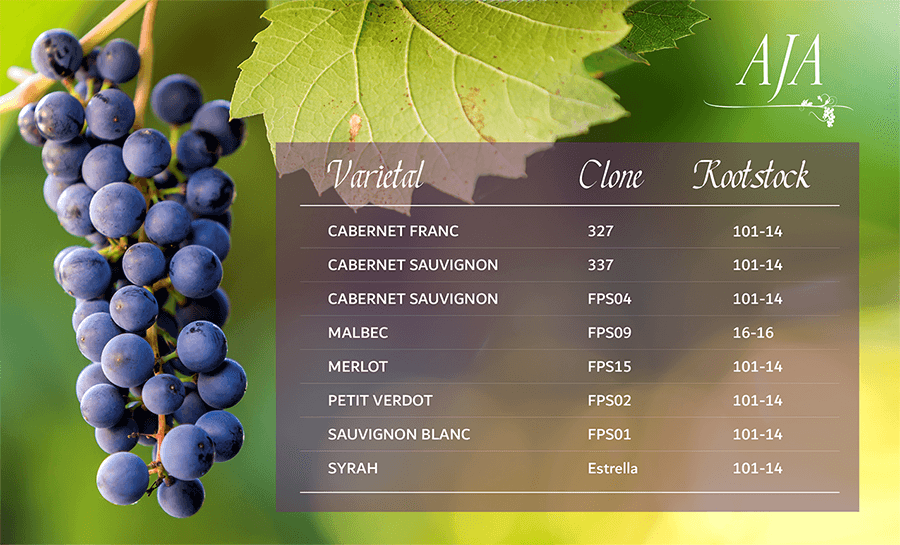Have you ever checked out our Our Wines page? Did you know we list the different rootstocks and clones of our wines?

You’re probably thinking:
Wait, Amanda, did you just say clones?? There’s More than One Type of Syrah?
Yes! There’s also more than one type of Cabernet Sauvignon, Chardonnay, Pinot Noir, Sauvignon Blanc and almost every single grape variety out there. They’re called clones and they’re extremely important to the way a wine grows, develops and eventually, tastes.
If you ever see on a wine label “Clone 4” “Wente Clone” “FPS 01” or more, these are some common clones of very popular varieties. Though you and I may know them as Cabernet Sauvignon, Chardonnay and Sauvignon Blanc (respectively), a vineyard manager and a winemaker might look at them differently. But in order to fully understand this, we have to go back to the basics.
Most European grape varieties fall under the category Vitis Vinifera which is a combination of the scientific genus name for a grapevine, vitis, and the name for this species of table or wine grape, Vinifera.
Back in the 1860s winemakers discovered Phylloxera, a deadly root louse that wiped half of the European vineyards. In order to save the vines from this root louse, winemakers quickly realized they had to utilize phylloxera resistant rootstocks. These rootstocks were found in other vitis species wines such as the United States’ vitis Labrusca. Though the vitis Labrusca grape varieties are not as common as the most widely planted varieties, the Labrusca rootstock is on most of the world’s vines today. Wineries began to use a process called grafting to fuse together the vitis Labrusca rootstocks to the vitis Vinifera vines. You may notice this in a vineyard by looking at the root of a vine and seeing what looks like a giant knot in the trunk. This is the product of grafted vines.
Each single variety i.e. Cabernet Sauvignon, Sauvignon Blanc, Petit Sirah, and more have their own definitive clones. Clones are mutations of specific varieties and are generally developed due to adaptation to climate, soil, and surroundings. As vines continued to grow in different areas of the world, adaptive mutations created wines that come from the same variety, but are slightly different. This happened both naturally, and forcibly. Just as we’ve created table grapes to taste like cotton candy, and seedless watermelon, wine has their own version of this.
An easy selection to discuss is one of the most widely planted grape varieties in the world: Cabernet Sauvignon. Cab has so many different clones; FPS 04, 337, FPS 12, to name a few. Yes, they’re all Cabernet Sauvignon, but they each accentuate different aspects of the variety. Some of these clones are better suited to cooler climates, while others are more suited for warm climates. Some clones are designed to have less tannins or pyrazines while others are designed to be more austere and bold. Some clones have smaller berries, like FP S04, and others have larger ones, like 337.
Other than accentuating certain elements of the fruit, this makes it so that we can plant the same varieties in different areas of the world. Selecting the right clone is an important process that encompasses both an understanding of the plant and the climate of the region. A winemaker and vineyard manager have to determine not only which clones will best grow in the region, but also determine which rootstocks will grow best in the region. Without the correct rootstocks, a vine can severely suffer from an inability to receive nutrients from the soil or inability to produce fruit or ample foliage. From there, winemakers and vineyard managers have to determine which clones are best suited for the rootstocks.
When a winemaker determines the style of wine they’d like to make, they can revert back to the clones to help guide them in the right direction. As we look at Cabernet Sauvignon from California versus Bordeaux, there are many differences in the wines, even though they’re both Cabernet Sauvignon. But if a Californian winemaker wanted to make a wine more similar in style to Bordeaux, they would likely want to look into more austere clones that gravitate towards retaining more acidity and ripen a little earlier. They would choose a clone that best works with specific strains of yeast to produce a dark complexion and provide a certain flavor profile like heavier tobacco and damp earth notes due to higher pyrazines.
Of course, clones are not the only factor in determining the flavor profile of the wine. But if clones were an ingredient in baking chocolate chip cookies, they’d definitely equate to the type of flour being used.
Hope you learned something interesting today to share with friends and family.
Cheers!
It always amazes me to see how knowledgeable you are. I love reading these blogs. Keep them coming.
Love you so much, Grandma